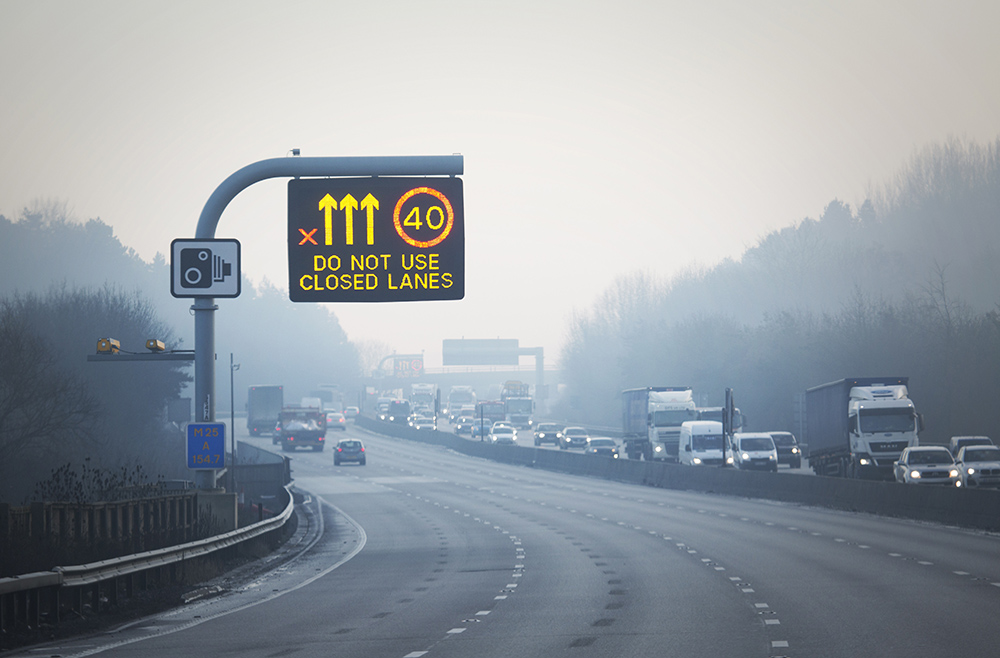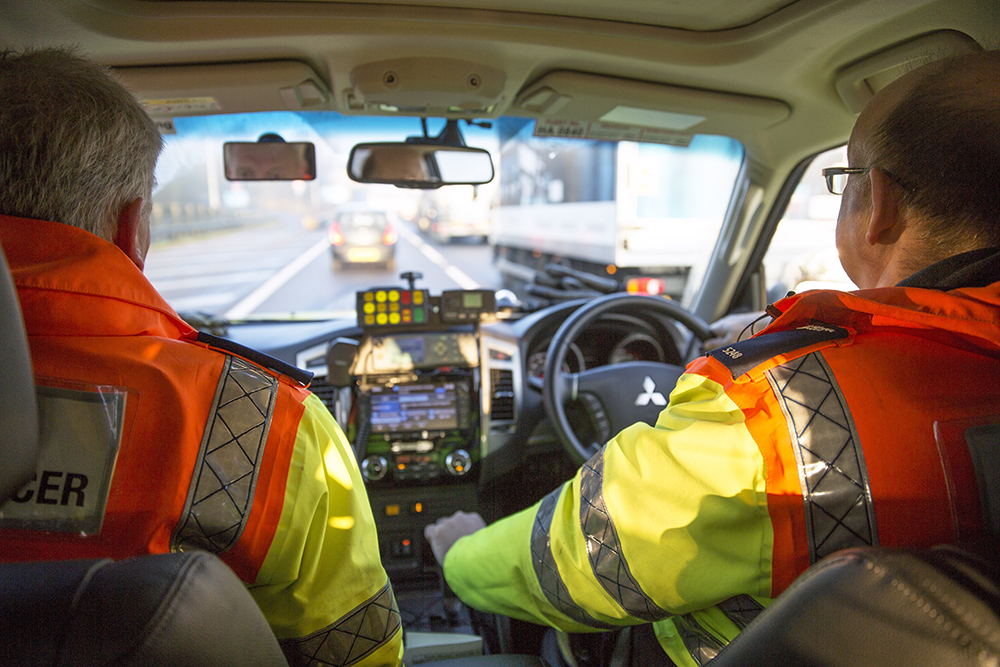
Given the weight of traffic that uses the UK’s motorway system, any project that can improve its capacity is likely to be given close examination by the country’s government.
Using hard shoulders to create additional lanes to improve traffic flow – especially at peak times – was always going to come to the top of ministers’ in-boxes. But there are real safety concerns: a recent BBC TV programme revealed that 38 people have been killed on the UK’s smart motorways in the last five years.
The attraction of such schemes was obvious: they held out the prospect of creating more capacity at considerably less cost than building new lanes, together with all the attendant disruption such extensions invariably create. However, after just a few years’ use, the whole concept is now under review by the UK government – and the BBC Panorama figures have added fuel to the doubters’ argument. Motoring organisations and safety groups have raised concerns that drivers and breakdown assistance teams are at risk.
Transport secretary Grant Shapps emphasised the need to sort out smart motorways because they are too confusing for drivers. “We absolutely have to have these as safe or safer than regular motorways or we shouldn’t have them at all,” he told Panorama.
He took the decision to review in late October 2019, telling UK members of parliament then: “We know people are dying on smart motorways.”
Dynamic confusion
This announcement came just 24 hours after the chief executive of Highways England, Jim O’Sullivan, defended the performance of smart motorways to MPs of the parliamentary transport committee. He said that such motorways were as safe as the conventional variety.
However, he admitted that drivers got confused with ‘dynamic hard shoulders’ [see box below, Get Smart]. “I do not think we will be building any more dynamic hard shoulder smart motorways. They are too complicated for people to use,” he admitted.
But O’Sullivan defended the safety performance of smart motorways as being as good as the conventional variety, commenting that this was all the more remarkable as smart motorways were - almost by definition - the busiest in the country.
While hard shoulders used for emergency stops on conventional motorways were safer than live lanes, he added, the emergency refuge areas provided at intervals along smart motorways were, in turn, safer than hard shoulders.
Given the hard shoulder’s traditional role as an area in which a broken-down vehicle can stop while awaiting emergency or breakdown services to attend, the obvious question has always been: ‘What happens when it is no longer available?’ That factor, plus the different types of smart motorway, have posed two of the biggest problems and risks for motorists, according to the AA, an influential UK motoring organisation.
Hard shoulder
The original smart motorway scheme was on the M42 motorway in England’s Midlands region. According to Jack Cousens, AA head of roads policy, this was designed to have a hard shoulder that would only be used at peak times and with emergency refuges every 500m.

“Everybody looked at the data and said: ‘That seems to work.’ What then happened, without consultation, was that the government and Highways England moved the goalposts and said: ‘We’re not going to do a dynamic hard shoulder where it’s only used at peak times, we’re going to use it permanently and increase the refuges from 500m apart to 2.5km.’
Cousens continued: “That was when we started to say: ‘Hang on a second. Firstly, you haven’t tested this and secondly, there’s been no consultation and we think these refuge areas need to be closer together’.”
Similar reservations came from another UK breakdown repair organisation, RAC. “While Highways England feels smart motorways are safe, we know many drivers believe that removing the hard shoulder compromises safety for those who break down in a live lane,” said RAC head of roads policy, Nicholas Lyes. “In early 2017 the government claimed there was ‘good progress’ being made in making smart motorways safer by reducing the space between SOS areas, ensuring drivers comply with red X ‘closed lane’ signs and rolling out stopped vehicle detection technology so anyone stranded in a live lane is quickly protected by lane closure signage.”

However, Lyes (left) believes that only a fifth of ‘all-lane running stretches’ of smart motorway are currently benefiting from stopped vehicle detection technology. This “hardly constitutes a roll-out”, he said. “We believe this technology needs to be retrofitted to all existing smart motorways as a matter of urgency.”
The RAC criticises what it sees as “a similar lack of progress in reducing the distance between SOS areas”. Lyes added: “Schemes currently under construction, and new ones being consulted on, still feature SOS areas at up to 2.5km apart as opposed to the lesser distance of 1.5km which we believe Highways England had committed to. We strongly believe the government should compel Highways England to make smart motorways as safe as possible by implementing these measures.”
Safety compromise
While the review of smart motorway safety is welcome, RAC says its own research suggests that drivers feel the permanent removal of the hard shoulder compromises their wellbeing. “They also tell us that emergency SOS areas are located too far apart,” Lyes said.
For Highways England, O’Sullivan believes that a major problem has been errors in the way that the agency has tried to explain the smart motorway concept.
“I think one of the mistakes we made was trying to explain all the different types to the public,” he told a conference last autumn. Referring to the signs displayed on overhead gantries warning motorists that individual lanes are closed, he said: “We should have put bandwidth into explaining red Xs and white arrows.”
UK newspapers’ coverage has been often unsympathetic. Numerous articles have focused on safety questions and smart motorways have even been branded ‘deathtraps’. However, O’Sullivan expressed genuine bemusement at the media furore. “I do find it hard to understand the gap between what we have done on smart motorways to make them safe and keep them safe and the perception that they aren’t safe that is often expressed in the newspapers and by some of the motoring organisations,” he said. “We know the accident rates on smart motorways are no different from conventional motorways. Both are among the safest roads in the world.”
His views met with some sympathy from David Davies, executive director of the Parliamentary Advisory Council for Transport Safety (PACTS), a charity that describes its aim as providing evidence-based information in contributions to transport debates. Speaking to ITS International, he said: “I think Highways England probably have the right statistics, but haven’t won the public argument. We want more of a public examination of the data.”
Sufficient explanation
While emphasising that PACTS had not taken a position on the smart motorway issue, Davies added: “We’ve not seen evidence saying fundamentally these are a bad thing. I think drivers are taking some time to get used to them and, yes, Highways England could do more work to get information across.”

The AA’s Cousens (right) agreed. Part of the difficulty with the smart motorway concept, he said, was that it had not been sufficiently explained to drivers: “There are three types of smart motorway and you don’t necessarily know about it unless you take an active interest, or realise [as you’re driving on them] that it’s a bit different.”
The biggest risk is a vehicle breaking down on the active hard shoulder, which places it at risk of being struck by a following vehicle. This danger is supposedly mitigated by cameras and radars on overhead gantries that are supposed to detect a vehicle that has been stationary for more than 12 seconds and trigger an alarm in a control centre.
However, said Cousens, the AA had concerns about the effectiveness of this ‘stationary vehicle detection’ radar technology. These radars were only positioned on two sections of the M25. “They’re being used as the flagship standard of which Highways England are saying these motorways are safer than traditional motorways with a permanent hard shoulder,” he points out.
In addition, the overhead cameras used to detect broken-down vehicles only pointed in a single direction at a time and relied upon them being traversed to cover both directions.
The UK governmental review of smart motorways may have been completed by the time these words are heard. It will then become apparent whether they remain a promising, congestion-easing measure or whether they are destined to disappear from the UK’s road network.
Get smart
The term ‘smart motorway’ actually covers three types of roads:
• a controlled motorway, with the normal three lanes plus a permanent hard shoulder, but gantries above the lanes showing variable speed limits
• a ‘dynamic hard shoulder’, where the hard shoulder is used on a temporary basis to cope with heavy traffic flows
• ‘all-lane running’, where the hard shoulder becomes a permanent fourth lane











